Adapt Movement is a unique rehabilitation facility in San Diego. While most rehabilitation and recovery practices focus on traditional methods of physical therapy, Adapt’s facility aims to blend modalities and disciplines in order to provide a personalized and integrative approach for overcoming the challenges of disability.
Ultimately, their goal is to minimize the impact disabilities have on a person’s life by tailoring individualized protocols and member experiences that encapsulate four core elements: Movement Recovery Programs, Mindfulness Practices, Reserve Building Activities, and Mobility Enablement Products and Devices.
We were lucky enough to get their team of experts in their field give us insight into which exercises WE should be doing with our partner at home to maximize their strength and mobility. We get tons of emails and messages weekly about workouts that we can do with our partners to help them in their recovery, so we were very blessed to get the insight of these wonderful trainers who specialize in just that!
We asked the trainers at Adapt to choose their TOP 3 most important and effective workouts/exercises for someone with SCI that can be done at home with little to no cost. Read on for their invaluable tips and advice!
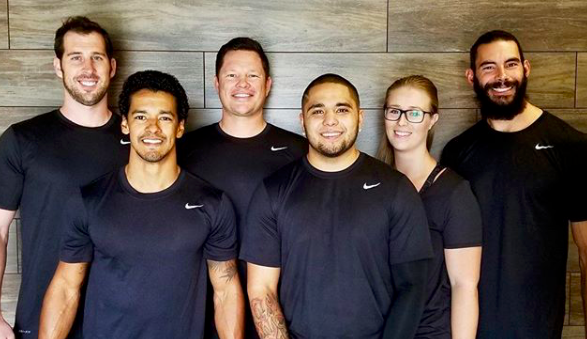
By ADAPT MOVEMENT STAFF for wagsofsci.com
Have you ever wondered what you could be doing at home to combat the chair position? I’ll tell you some ways that you can do so with the help from your partner. These exercises will help to improve your: Skeletal Health, Posture, Cardiovascular Health, Overall Fitness and Independence.
All of the exercises are not only beneficial in many ways but will include minimal equipment so that anyone can implement them into a daily routine. So grab your partner and let’s get started!
Stretching and Range of Motion
It is important for us to keep a natural resting length in all of our muscles in order to maximize the ability of muscle contraction. They should not be too loose or too tight. Being in the wheelchair position for long amounts of time can both shorten muscles like the hip flexors and hamstrings as well as lengthen the antagonist muscle groups. Let’s focus on stretching the shortened muscles and providing safe and adequate range of motion through the hip and knee joints.
Stretching The Hamstrings
Partner: Grab his foot with one hand and place your other hand on his knee. Raise his straight leg until a stretch is felt. If he cannot feel a stretch, go to about a 45 degree angle and hold for 10-20 seconds. Do this 3 times for each leg.
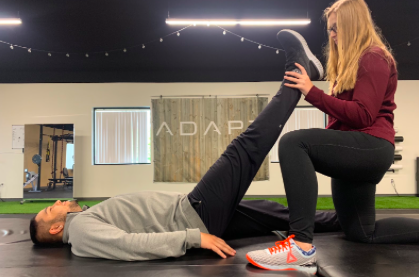
Stretching Of The Hip Flexors
Partner: Help to get him into a prone position (stomach down) if he needs it. Just being in this position is lengthening out the hip flexors that are always flexed while sitting in the chair. To provide more of a stretch, help him to get onto his elbows or hands to provide more extension of the hips. Do this 3 times for 10-20 seconds at a time.

Rotation of the Spine
Being in the chair position can cause a lot of people to think about the curves in their spine. Questions like: “Am I slouching?” and, “How’s my posture?” are constantly being thought of and addressed, which is good, but rotation is often forgot about. Here is great exercise, called Upper Spinal Floor Twists, that can help improve spinal mobility. This exercise will be performed in a side-lying position.
Partner: Help him get into a 90-90 position, meaning flexed 90 degrees at the hips and knees. Place a pillow between his legs. Block his hips with your foot and help him to rotate his thoracic region by rotating his top arm across and behind him. Press down on his shoulder to provide a stretch. Then do rotations back and forth 20 times. Repeat this for the opposite side.
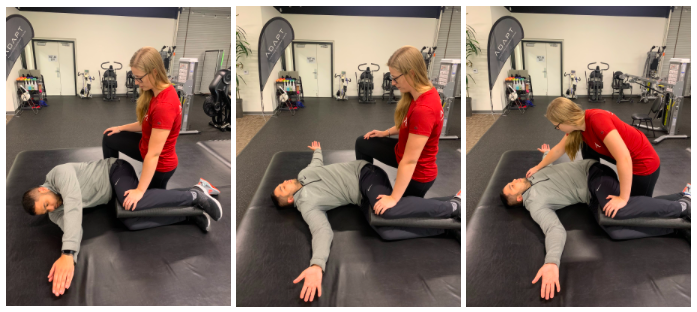
Cardiovascular Exercise
It is often challenging for wheelchair users to find a way to implement some type of cardio into their exercise routine. Cardiovascular exercise helps to improve blood circulation, strengthen the heart and lungs, burns calories for weight loss, and much more. Here is a fun and challenging way, both a paraplegic and quadriplegic, can improve their cardiovascular health.
Battle Ropes
Using battle ropes is a great way to get the body moving and heart pumping! They usually cost ~ $30-$50, but you will certainly get your money’s worth with these exercises!
Partner: Anchor the battle rope down to a fixed point. Make sure there is a little slack in the rope so that it can be manipulated by him fairly easily. Don’t worry, this will be challenging! He can perform this exercise in his chair or seated on a low table. If performing on a low table and balance is an issue, provide him with some sort of back support like a box or wall. You can also spot him by holding onto the tops of his shoulders, if needed.
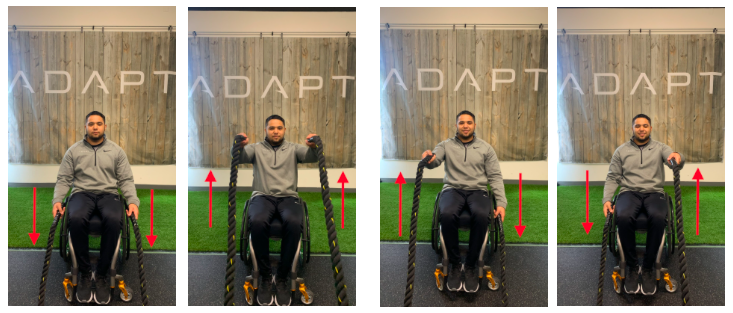
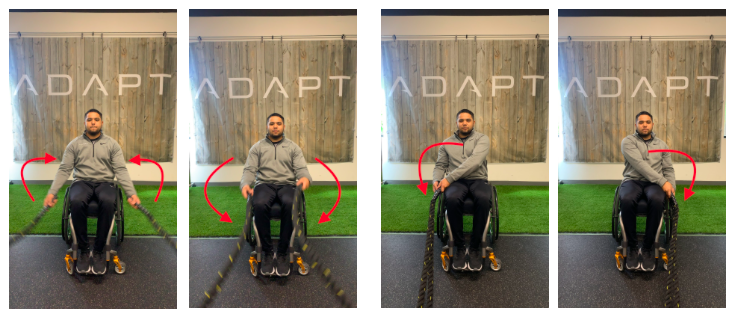
Perform these movements in 30-second intervals (30 seconds on, 30 seconds off). Double Arms, Alternating Arms, Internal Rotations, External Rotations, Side-to-Side.
(See pictures for details on each exercise). Push for 3 sets of all 5 exercises with adequate rest inbetween sets. Once this becomes too easy… you can progress to 60-second intervals.
Over to you...
Can you complete all 3 exercises? How do you feel afterwards? What exercises have you used to combat the chair position or kick your butt and keep you fit? Share in the comments below.
If you liked this blog post, share it with a friend!
Here is the link to Adapt Movement's website: https://adaptmovement.org
You can also follow them on Instagram here
And on Facebook here
